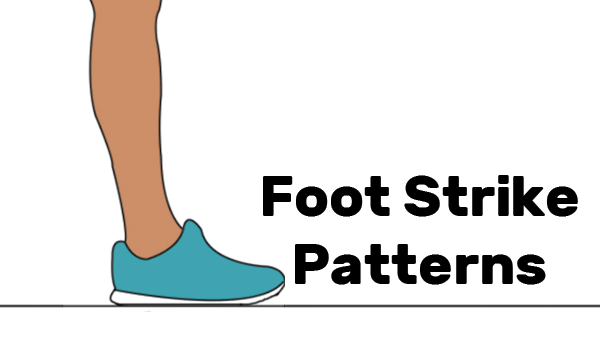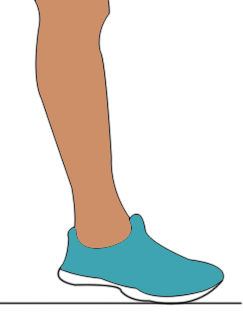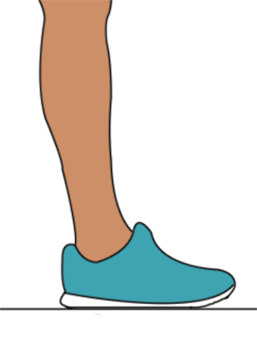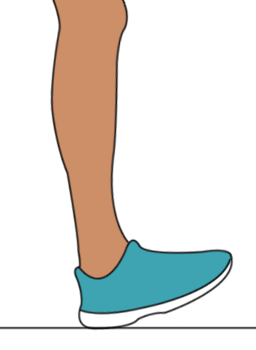
Foot strike is a controversial topic among runners.
Many advise running with either a forefoot strike or a midfoot strike. They believe these two foot strikes are better for performance and help you avoid injuries.
On the other hand, some runners think that foot strike is something that comes naturally, and there is no need to change it.
Let’s explore this topic in this post. It will help you decide if you should change your foot strike or not.
Types of Foot Strikes
When it comes to foot strike, there are two main aspects:
- Which part of your foot strikes the ground first and,
- Where your foot strikes the ground relative to your center of mass
Based on the first point, there are three types of foot strikes:
1. Forefoot Strike

In the forefoot strike, you land on the balls of your feet. The heel never touches the ground. This is common with short distance runners. You can see sprinters running on the balls of their feet looking like they are running on their toes.
2. Midfoot Strike

In a midfoot strike, both your heel and the forefoot (the balls) come into contact with the ground at the same time. It’s common with short distance and middle-distance runners.
3. Rearfoot strike

In a rearfoot strike (aka heel strike), the first thing that comes in contact with the ground is the heel. Then the foot rolls forward and the forefoot comes in contact with the ground, eventually leading to the toe-off phase.
This is the most common type of foot strike in long-distance runners. Also, the majority of recreational runners tend to be heel strikers.
Understanding a bad heel strike
Let’s take a look at two heel strikers. Runner A strikes the ground with her heel first – but her foot quickly rolls forward to the push-off phase – shifting her weight throughout the foot. Additionally, her foot lands below her center of mass. And she has a fairly higher cadence. It’s most likely that this runner won’t suffer from injuries because of the foot strike (at least). In this article, we’re referring to this type of heel striking.
Now, runner B also strikes the ground with her heel but the load doesn’t shift as quickly as Runner A’s. Her feet also land ahead of her center of mass with her toes facing upward. This one is nasty; and more likely to lead to an injury. This should definitely be changed.
Where your foot lands on the ground relative to your center of mass is very important. If you land ahead of your center of mass, it means you are overstriding. It puts you at risk of getting injured. So always aim to land below your center mass.
What the studies say about foot strike patterns
Let’s take a look at some studies to see the foot strike of runners around the world:
Foot Strike Pattern of Non-Elite Runners:
A study of recreational runners during a 15km road race categorized runners in two groups – rearfoot strikers and non-rearfoot strikers. The researchers observed that at the 3km mark, 76.9% of the runners were heel strikers. This percentage further increased to 91% at the 13km mark – indicating that a huge number of runners changed to rearfoot striking later on. The study also pointed out that the fastest runners were those who consistently ran with a non-rearfoot strike.
Another study that recorded foot strikes of runners at 8.1km mark found 93.67% of the runners were heel strikers.
Foot Strike Pattern of Elite Runners
A study of foot strike patterns of elite runners during a half marathon (at 15-km point) concluded:
- The percentage of rearfoot strikers, midfoot strikers, and forefoot strikers was 74.9%, 23.7%, and 1.4% respectively.
- The percentage of midfoot strikers was higher in the faster runners group.
- In the top 50 runners group, the percentage was – 62% rearfoot strikers, 36% midfoot-strikers, and 2% forefoot strikers.
Another study of elite marathon runners at the 2017 IAAF World Championships categorized runners in two groups – rearfoot strikers and non-rearfoot strikers. The latter group included both midfoot strikers and forefoot strikers. The study concluded:
- The most common foot strike pattern was the rearfoot strike.
- As most athletes were rearfoot strikers (including the top 4 finishing men), it seems that there is no clear advantage of forefoot strike or midfoot strike in marathon running.
- Some runners switched to rearfoot strike from either midfoot or forefoot strike as the distance increased.
- The study further added that it is normal for elite marathoners to choose any type of foot strike; however, the forefoot strike was rare.
Should You Change Your Foot Strike?
A paper published in Journal of Sport and Health Science reviewed several studies. The authors wanted to find out if there were any benefits of changing from heel strike to forefoot or midfoot strike. They concluded:
- There are no obvious benefits to such a change for the majority of runners.
- Changing foot strike may result in a secondary injury because of the stress on some tissues that are not used to the new load.
- Changing one’s footstrike to a midfoot or forefoot strike may be beneficial to some but it should not be recommended for the majority of runners, particularly recreational runners.
- There is no solid scientific evidence to suggest that midfoot or forefoot strike improve performance or reduce the risk of running-related injuries.
Things to Consider Before Changing Your Foot Strike
So we know that runners choose foot strikes that they are most comfortable in. But there could be a reason you want to change your foot strike. Maybe you feel uncomfortable with your current one. Or maybe you just want to experiment.
Keep the following in mind when you want to change your foot strike:
- Your running experience matters. If you are just starting out, you may experiment with different types of foot strikes; and choose the one that feels most comfortable to you. But if you have been running for years, your body has already chosen the appropriate foot strike. And it may not be a good idea for you to change it.
- Changing foot strike means there will be stress on new muscles. Those muscles are not used to handle that stress. For example, forefoot running increases loading on the foot arch and increases pressure on foot muscles. This is the reason you need to be very careful when trying a new foot strike. Don’t change your foot strike at once. Do it gradually.
Things to Help You Avoid Injuries
- Make sure that you don’t overstride. Your feet should land below your center of mass.
- A slight forward lean will also help you avoid overstriding.
- Focus on a higher cadence. Take shorter quicker steps. This will help you reduce excessive up-and-down movement and ground contact time. 180 steps per minute is a good target.
- Whatever your foot-strike, you should aim to run as effortlessly as possible. Think smooth.
- Focus on good running mechanics.
Key Points
- Foot strike patterns can change with the race distance, surface, and runner’s experience.
- Our body automatically chooses a foot strike that it feels most comfortable in.
- There is no solid scientific evidence that suggests forefoot or midfoot strikes are better than a heel strike.
- Changing heel strike works for some runners, but it cannot be recommended for every runner.
- Changing the foot strike will put stress on some muscles that are not used to it. So if you intend to change your foot strike, do it gradually.
